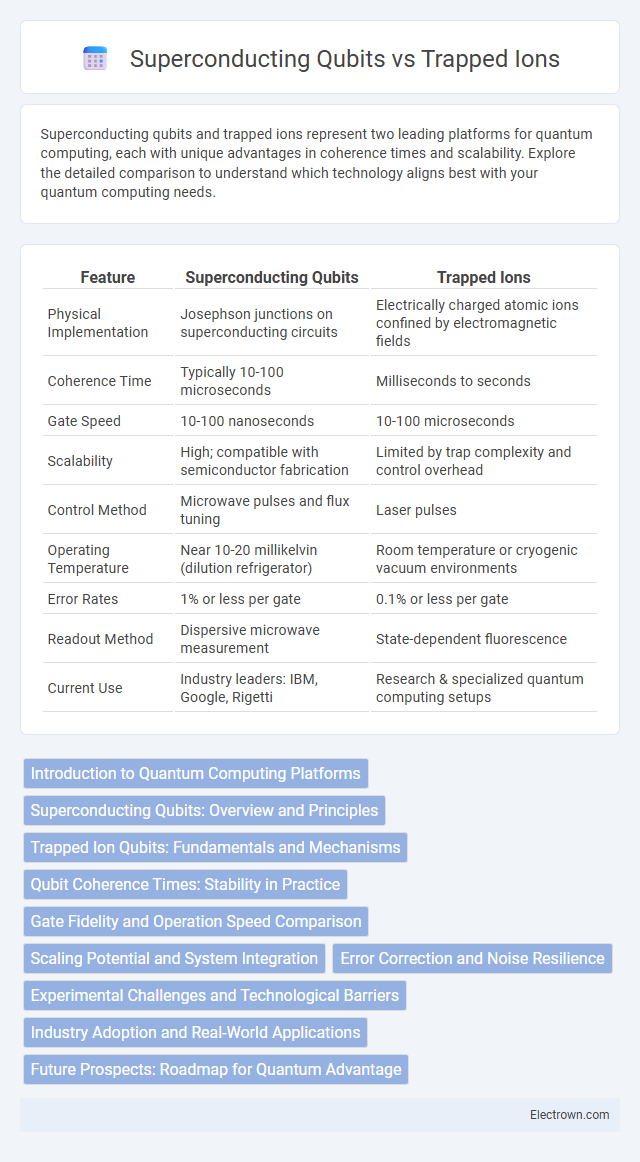Superconducting qubits and trapped ions represent two leading platforms for quantum computing, each with unique advantages in coherence times and scalability. Explore the detailed comparison to understand which technology aligns best with your quantum computing needs.
Table of Comparison
| Feature | Superconducting Qubits | Trapped Ions |
|---|---|---|
| Physical Implementation | Josephson junctions on superconducting circuits | Electrically charged atomic ions confined by electromagnetic fields |
| Coherence Time | Typically 10-100 microseconds | Milliseconds to seconds |
| Gate Speed | 10-100 nanoseconds | 10-100 microseconds |
| Scalability | High; compatible with semiconductor fabrication | Limited by trap complexity and control overhead |
| Control Method | Microwave pulses and flux tuning | Laser pulses |
| Operating Temperature | Near 10-20 millikelvin (dilution refrigerator) | Room temperature or cryogenic vacuum environments |
| Error Rates | 1% or less per gate | 0.1% or less per gate |
| Readout Method | Dispersive microwave measurement | State-dependent fluorescence |
| Current Use | Industry leaders: IBM, Google, Rigetti | Research & specialized quantum computing setups |
Introduction to Quantum Computing Platforms
Superconducting qubits and trapped ions represent two leading quantum computing platforms, each leveraging distinct physical principles to process quantum information. Superconducting qubits use microwave photons in superconducting circuits cooled to near absolute zero, enabling fast gate operations and scalability for quantum processors. Trapped ions utilize electromagnetic fields to confine ions in vacuum, providing exceptional coherence times and high-fidelity quantum logic gates, making them strong candidates for error-corrected quantum computing.
Superconducting Qubits: Overview and Principles
Superconducting qubits utilize Josephson junctions to create quantized energy levels that serve as quantum bits, operating at ultra-low temperatures near absolute zero to maintain coherence. Their planar fabrication on silicon chips allows for scalable integration with microwave control circuits, enabling fast gate operations typically in the nanosecond range. You benefit from their compatibility with existing semiconductor technology, which facilitates rapid advancements in quantum processor size and complexity.
Trapped Ion Qubits: Fundamentals and Mechanisms
Trapped ion qubits utilize ions confined by electromagnetic fields in ultra-high vacuum to encode quantum information with exceptional coherence times and high-fidelity quantum gate operations. These qubits leverage the ions' internal electronic states as well as motional modes for entanglement, controlled via precisely tuned laser pulses that manipulate quantum states without decoherence. Your quantum computing system benefits from the intrinsic scalability and stability of trapped ion qubits, making them a leading platform for fault-tolerant quantum computation.
Qubit Coherence Times: Stability in Practice
Superconducting qubits typically exhibit coherence times ranging from tens to hundreds of microseconds, limited primarily by material defects and environmental noise, which challenge long-term stability in practice. Trapped ion qubits, benefiting from atomic-level isolation and electromagnetic trapping, achieve coherence times on the order of seconds to minutes, providing superior stability for quantum computations. The longer coherence times in trapped ions enhance error correction and gate fidelity, positioning them as a promising platform for scalable, stable quantum processors.
Gate Fidelity and Operation Speed Comparison
Superconducting qubits typically achieve gate fidelities around 99.9% but excel in operation speeds with gate times in the range of 10-100 nanoseconds, enabling rapid quantum computations. Trapped ions offer higher gate fidelities exceeding 99.99%, providing exceptional accuracy, though their gate operations are slower, generally lasting tens to hundreds of microseconds. Your choice depends on whether prioritizing ultra-fast processing or superior precision fits your quantum computing application.
Scaling Potential and System Integration
Superconducting qubits offer high scalability through lithographic fabrication, enabling integration of thousands of qubits on a single chip with established semiconductor manufacturing techniques. Trapped ions provide excellent qubit coherence and connectivity but face challenges in scaling due to complex ion trap architectures and difficulties in integrating large numbers of ions. Your choice depends on balancing the scalability and system integration advantages of superconducting qubits against the superior coherence properties of trapped ions.
Error Correction and Noise Resilience
Superconducting qubits typically exhibit faster gate speeds but face challenges with higher error rates and noise sensitivity compared to trapped ions, which benefit from longer coherence times and intrinsic noise resilience. Error correction in superconducting qubits requires complex surface codes and frequent calibration to manage decoherence and flux noise, whereas trapped ions leverage their stable atomic transitions to implement error correction with fewer logical qubits. Your choice between these platforms should weigh the trade-offs in noise resilience and error correction overhead relative to the quantum algorithm and hardware scalability needs.
Experimental Challenges and Technological Barriers
Superconducting qubits face experimental challenges such as maintaining ultra-low temperatures around 10 millikelvin and mitigating decoherence from materials defects and electromagnetic noise. Trapped ions require precise laser control and ultra-high vacuum environments to isolate qubits from external disturbances and reduce motional decoherence. Your choice between these technologies depends on balancing scalability constraints with the complexity of error correction and control systems inherent in each platform.
Industry Adoption and Real-World Applications
Superconducting qubits are widely adopted by major companies such as IBM, Google, and Rigetti, enabling rapid advancements in quantum processors with applications in optimization, cryptography, and material science. Trapped ions, favored by firms like IonQ and Honeywell, excel in high-fidelity quantum operations, making them ideal for precision sensing, quantum simulations, and error correction research. The differing industry adoption reflects superconducting qubits' scalability advantages and trapped ions' superior coherence times, shaping distinct use cases in the evolving quantum computing market.
Future Prospects: Roadmap for Quantum Advantage
Superconducting qubits offer rapid gate speeds and scalability on integrated circuits, aligning with current efforts to build large-scale quantum processors essential for achieving quantum advantage in practical applications. Trapped ions provide superior coherence times and high-fidelity operations, making them ideal for error-corrected quantum computing and precision quantum simulations in the roadmap toward fault-tolerant systems. Your choice between these platforms will depend on balancing scalability, coherence, and ease of quantum error correction as the industry advances toward commercially viable quantum technologies.
superconducting qubits vs trapped ions Infographic

 electrown.com
electrown.com